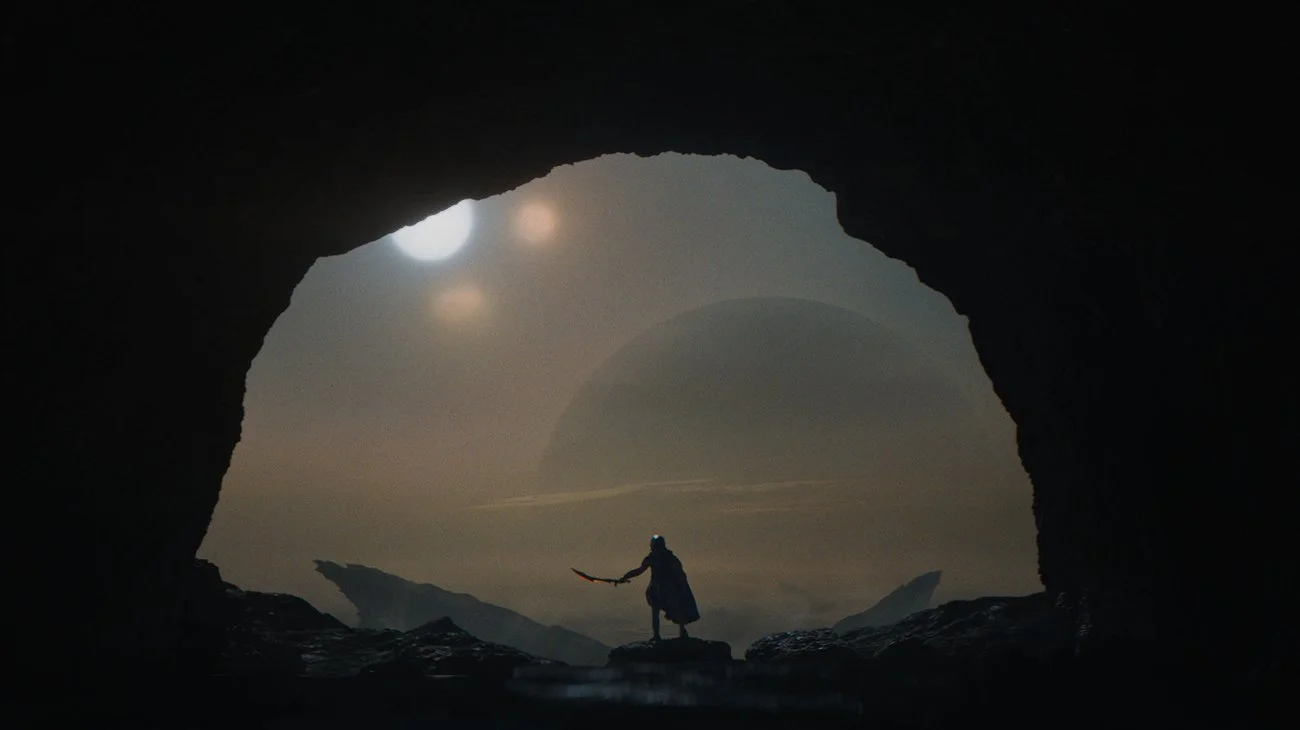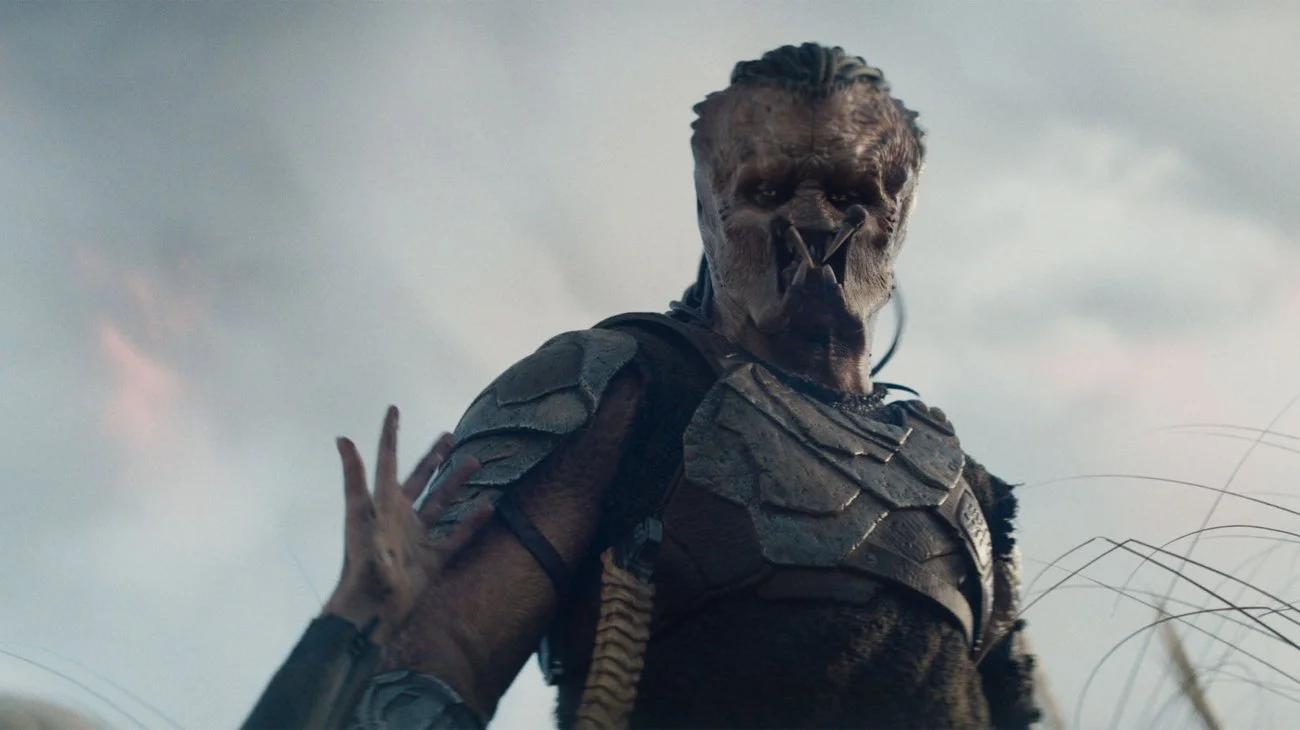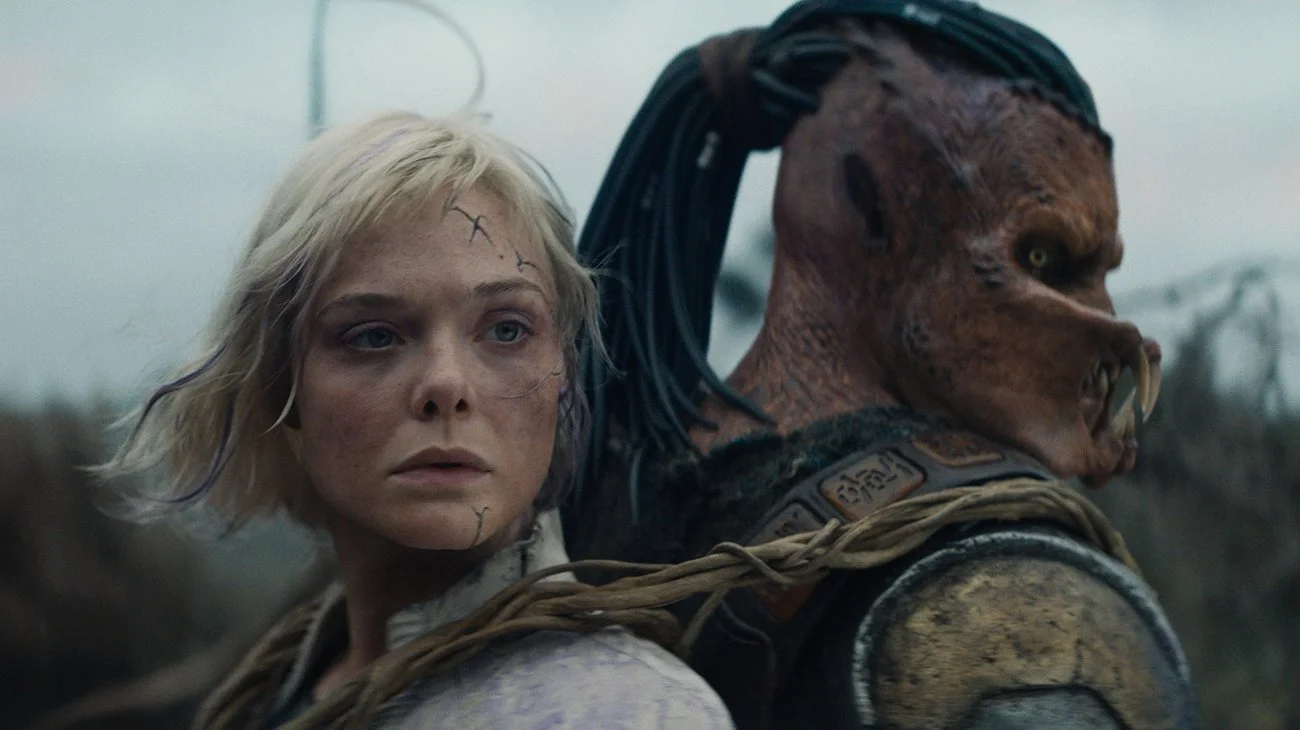‘Predator: Badlands’ REVIEW: All Killer, No Filler
‘Predator: Badlands’ REVIEW: All Killer No Filler
Dimitrius Schuster-Koloamatangi as Dek in 20th Century Studios' PREDATOR: BADLANDS film. Photo courtesy of 20th Century Studios.
This is a film about the things that make us human. It is a film of vulnerability, empathy and sensitivity. If that doesn’t sound like your kind of thing, then consider too that it is a film of laser swords, mech suits, and self-regenerating kaiju. The film is called Predator: Badlands after all, and it delivers on the promises of that title and then some. For a film that feels like it has a big, beating human heart at its center, it’s surprising that this is not only the first Predator film that features the titular alien species (also known as the Yautja) in the lead, but that there are no humans in the film at all.
Perhaps audiences are no longer strangers to seeing aliens lead franchise films. Sci-fi blockbusters like Avatar, and the Star Wars and Marvel franchises have extraterrestrials at the center of their stories (if not quite leading them yet in every case). But compared to the Na’vi, Baby Yoda, and Groot, the Predator is perhaps not the friendliest face to hinge a franchise on.
Director Dan Trachtenberg goes for it anyway. Badlands ends up hewing closer to Star Wars and Marvel than to previous films in the Predator series, resembling more a crowd-pleasing hero’s journey than a stalking slasher-horror, just with a reptilian alien that Arnold Schawarzenegger’s character Dutch in the original Predator once called “one ugly motherfucker” standing in for Luke Skywalker. Fans hoping for something closer to the original or to Trachtenberg’s first live-action entry in the franchise, Prey, may be disappointed. This is a wholly different kind of film for the franchise, a brisk action-adventure that’s all killer no filler.
Dimitrius Schuster-Koloamatangi as Dek in 20th Century Studios' PREDATOR: BADLANDS film. Photo courtesy of 20th Century Studios.
Dek (Dimitrius Schuster-Koloamatangi), a young Yautja, is a disappointment to his father, the leader of the Yautja clan. Despite being an advanced and intelligent species, the Yautja still obey the laws of the wild, where the strong survive and the runts are left to die. Empathy has no place among killing machines. As the runt of the clan, Dek falls well below expectations for a Yautja. Any creature that has to realistically go head-to-head with 80s Schwarzenegger must be taller and even more muscular than him to pose a threat.
The Yautja are typically huge and built, and while Dek is by no means a shrimp, next to his brethren, he is noticeably less imposing. Dek is roughly Schwarzenegger-size, which is great if he was a human and terrible because he’s a Yautja. If they had songs on his home planet Yautja Prime, he could probably relate to the words of Jaden Smith: “Now he's bigger than me, taller than me, And he's older than me, and stronger than me, And his arms a little bit longer than me…” Try as he might, he doesn’t meet the natural-born killer standard, and in the Yautja clan, that can only mean death.
Dek’s only consolation is that being an alpha macho man has never been an advantage in the Predator franchise. Big guns and bigger muscles are near-useless in the face of the ruthless Predator. The original film spends its first half-hour showcasing the military might of the 80s action hero, with Arnold Schwarzenegger and company unloading round after round of machine gun fire into a faceless enemy without so much as a scratch taken from return fire. These guys are made to be unkillable, so that when the Predator shows up and starts cutting them down one-by-one, slasher-movie style, we understand just how powerful it is. The Yautja culture Dek comes from is not that different from the military culture of Dutch’s elite team. Every Yautja must be an apex predator, a true killer of killers.
To prove his worth — and prove his father wrong — Dek must embark on the coming-of-age journey required of all Yautja, selecting one predator in the universe to hunt and kill, and survive to tell the tale, bringing its head back home as a trophy, proving the Yautja’s hierarchy in the galactic food chain. With a chip on his shoulder, Dek doesn’t go for some easy small fry to get the journey out of the way; an underdog needs a superior antagonist, and Dek chooses to hunt the Kalisk, the one species thought to be unkillable.
Dek is thoroughly unprepared for his hero’s journey, jetting off last second without preparation, smashing his ship into an asteroid field, and crash-landing onto Genna, the hostile planet home to the Kalisk and a host of deadly creatures Dek doesn’t even anticipate. To kill the Kalisk, he must first contend with an ecosystem trying to kill him first at every turn.
Genna is a well-realized planet teeming with life. There is no shortage of unique creatures inhabiting it, each with different functions and abilities. It’s a sound designer’s dream to build out this alien world and give each creature its own sense of character, from their vocalizations to their movements. These things don’t exist in real life so the sky’s truly the limit. Certain species are named after real-world animals, like the Genna Vulture or the Bone Bison, but on Genna, they are a hundred times deadlier than their namesakes.
The Vulture more resembles a dragon, and the Bison is a cross between a triceratops and an elephant, sporting axe-like horns and using its mass and tough hide to bulldoze anything in its way. Even the terrain can be deadly, as Dek learns when he tries to charge right at a Bone Bison grazing on a grassy field and cuts himself, drawing blood, realizing that the grass is actually made of glass-like shards.
The iconic line from the first Predator, “If it bleeds, we can kill it”, is felt in Badlands. Dek does bleed, and is more vulnerable than he cares to admit. He gets cut, banged up, thrown around. When he tries to collect himself after crash-landing into Genna, arranging all his gear and weapons, testing them out, planning his next move, he is interrupted by sentient tree vines that sneak up on him, swiping away his arsenal behind his back, leaving him with nothing but his sword. The vines whip at him faster than he can cut them down, and even when he does manage to hold back their assault, they seem to only double in size. Dek is left without all the gadgets a Predator is known for, like its helmet with infrared vision and the shoulder-mounted laser cannon.
Though the Predator is often visualized with its helmet on, the lack of a helmet in Badlands allows Dek to be far more expressive than any previous incarnation of the Predator. Schuster-Koloamatangi’s excellent physical and vocal performance blends perfectly with the CGI to bring this Predator to life. Dek puts up the tough guy act, and he has his fair share of screengrab-worthy badass moments, but he’s at his most interesting and unique when he expresses emotions you wouldn’t expect from a Yautja. When Dek finally gets a better glimpse at Genna after barely escaping the vines, a wide-eyed terror plays across his face, struck by the vast landscape ahead. For once in the franchise, a Predator actually feels dwarfed by their mission.
Like Dorothy along the yellow brick road, Dek meets a couple companions on his journey. His “Tin-Man” is Thia (Elle Fanning), an incapacitated Weyland-Yutani artificial intelligence (also known as a Synthetic or Synth, from the Alien franchise), missing the lower half of her torso, stranded and alone in the nest of a Genna Vulture following a Kalisk attack on the research outpost she mans with a crew of other synthetics, including a “twin sister” Tessa (Fanning pulling double duty).
Initially disinterested in saving Thia and bringing her along with him, Dek is successfully convinced when she appeals to his practicality rather than his emotions, calling herself a “tool” for him to use, even if she knows she’s much more than that. Though Thia does not have a heart in the literal sense, she doesn't feel the need to go knocking on anyone’s door to ask for one. Describing herself and Tessa to Dek, she explains that, among the crew of synthetics researching the creatures on Genna, she and Tessa have a “higher sensitivity”. Dek matter-of-factly responds as he’s been taught, “Sensitivity is weakness.” She gently corrects him, “Sensitivity is what allows us to understand the creatures on this planet.”
Dek and Thia make for an excellent buddy duo. It’s a tale of two misfits; the Predator that feels too much in a culture that rejects those feelings meets the Android that feels too much too. Where he tries to bury the feelings and project the image of a hardened warrior, she counters with a bubbly personality, constantly poking and prodding at him, trying to make small talk as they traverse the planet, all while strapped to his back like a backpack. He’s a lone wolf suddenly saddled with a chatterbox that explains that the true strength of the wolf is the pack. Rejected by his own pack, he doesn’t quite buy it. She attempts to teach him about the world of Genna, showing him how to work with and not against the ecosystem. He can only see a kill or be killed world but learning to survive means understanding that not every situation calls for a laser sword. Their chemistry is the backbone of the film, and without that rapport the film would not be nearly as entertaining, nor would it have a heartfelt center.
They can bond over parental disdain too; just as in Alien, the Weyland-Yutani research mission is overseen by an AI known as “Mother” (stylized as MU/TH/UR), monitoring the crew and ensuring that everything goes according to the company’s directives. The Weyland-Yutani Corporation has a similar objective to Dek. They want to capture the Kalisk and research its special, “unkillable” properties. When cut down, the Kalisk simply regrows its limbs and reattaches its severed parts.
As evidenced by their multiple efforts to capture and harness the power of the Xenomorph in the Alien films, Weyland-Yutani blindly follows the power and money to the most destructive ends. The corporation’s end goal with the research is unclear, though as one of cinema’s great examples of capitalism running amuck, it can’t be for anything good. It calls to mind an earlier film in the Alien franchise, Prometheus, wherein Weyland-Yutani CEO Peter Weyland seeks the answers to immortality from the engineers of the human race.
Weyland sees creating the synthetics as a god-like achievement, therefore he believes he has earned the immortality and status of a god. It’s ironic that, by creating the synthetics, the Weyland-Yutani discovered a kind of immortality, just not for themselves. A shot of the Kalisk regenerating its limbs and reattaching its severed head is intercut with Thia reattaching her own severed limbs, not-so-subtly suggesting that they are more alike than they are different.
A scene from 20th Century Studios' PREDATOR: BADLANDS film. Photo courtesy of 20th Century Studios.
Badlands is Saturday-morning cartoon level action-packed, though not every action sequence lands perfectly. An early duel in a cave between Dek and his brother, Kwei, is hard to follow. Not only does it take place in a darkened interior, the shots are also held tightly and cut together quickly, resulting in a fight that’s more dizzying than thrilling. The visual effects in this sequence are also not up to par with the rest of the film, looking and feeling weightless when the characters leap and bound across the frame. The cave also doesn’t make for a very interesting location here, especially when compared to how alive Genna feels.
Once Dek crash-lands onto Genna — which doesn’t really take the film too long — the action goes up a notch. There’s a great sense of anticipation around every corner as Dek comes face-to-face with all the hostilities the planet has to offer. I found myself asking what new, dangerous thing would come to one-up the last one, and the film does not run out of things to throw at Dek, including one last giant showdown that tops them all.
I won’t give it away here, but the visual will be recognizable to any Alien fan. Elle Fanning isn’t left on the sideline either, as are both Thia and Tessa. Thia spends most of the film missing her legs which has the double purpose of forcing the two leads of the film together and setting up a ridiculously fun fight scene later on that I won’t give away too; suffice to say that I’ve never seen anything like it.
In the 2022 film Prey, Trachtenberg reimagined the Predator franchise formula, setting the series well in the past, pitting the fearsome Yautja against a Comanche warrior, an opponent with a much smaller arsenal compared to anyone in the series prior. Her hand-drawn bow and arrow vs the Predator’s laser-guided arrow gun clearly visualizes just how uneven a matchup it is, which makes it all the more compelling to see how she emerges victorious using all the wit and skill behind the tools. It’s a fantastic underdog story.
With Predator: Badlands, Trachtenberg pulls the same trick, remixing the series once again, this time in the mold of a space opera like Star Wars, delivering an unlikely protagonist and dropping them into a fight that they may not be fully prepared for. What could be more unlikely than a Predator that isn’t prepared to fight? Trachtenberg pulls just as unlikely an answer: Dek’s greatest survival asset is not his strength, but his sensitivity.
Predator: Badlands is now showing in cinemas nationwide.























